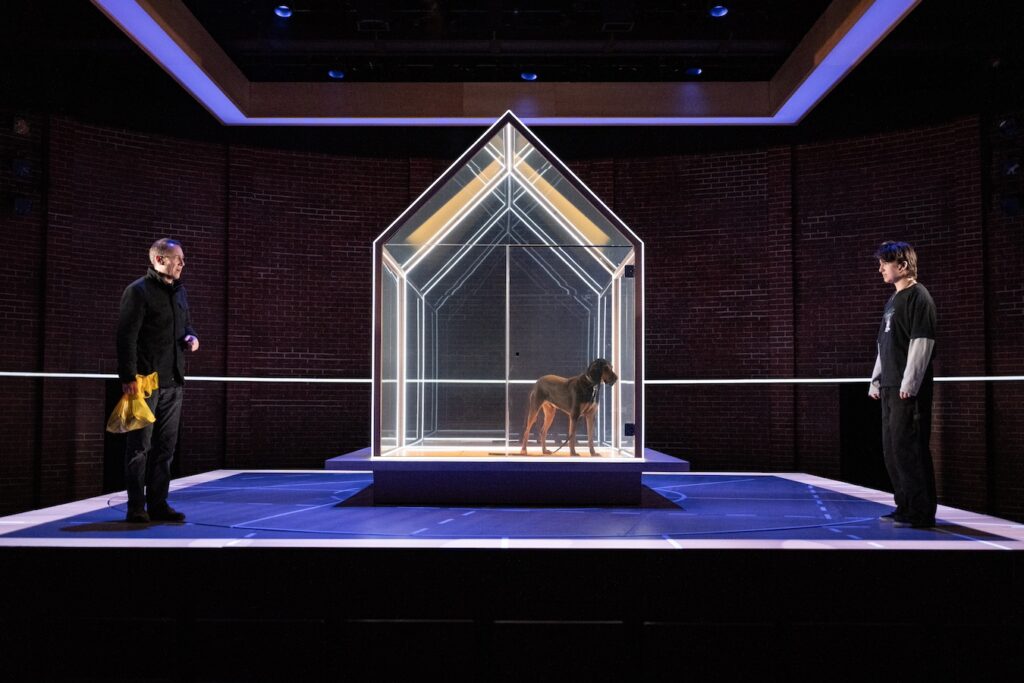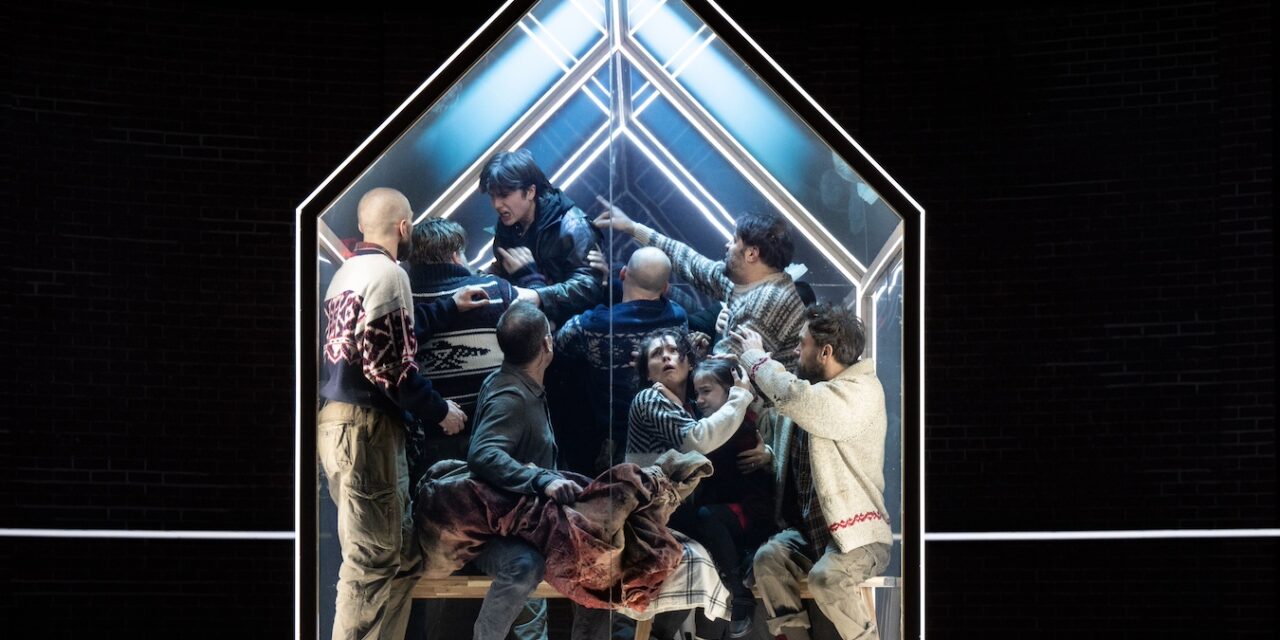Theater Review by Carol Rocamora . . . .
Brace yourselves.
Rupert Goold’s riveting production of The Hunt, now playing at St Ann’s Warehouse in Brooklyn, will have you hanging onto your seat—and often hiding under it.
Rarely have I been as shaken in the theater by the power of a story—augmented by sensational directing and design. A thriller, tragedy and social commentary all in one, The Hunt takes you on a terrifying, 100-minute ride, leaving you emotionally eviscerated and incredulous that what you’ve just witnessed could possibly have happened.
Set in a small town in Denmark, The Hunt tells the story of Lucas (Tobias Menzies), a kindergarten teacher, and what happens to him at the local school where he serves with complete dedication. Lucas is falsely accused by one of his five-year-old students of sexual abuse—a shocking and completely unfounded accusation that soon spins out of control and whips the entire town in a frenzy. Everyone turns against him, including his best friend Theo (the father of the child who accuses him), his school principal, and all the members of the men’s Lodge to which he belongs. His sole supporter is his sixteen-year-old son Marcus who has come back to live with him after the separation of Lucas and his wife.

Lucas is a fascinating character study, straight out of the Scandinavian dramatic tradition set by Ibsen—namely, a man who stands alone against an unjust society. Except that, unlike an Ibsen protagonist, Lucas doesn’t fight back. Self-effacing and soft-spoken, he does not defend himself against the brutal accusations that crescendo to a violent attack. There are some isolated instances of support—from his son Marcus, as well as from Clara‘s mother, who suspects that her daughter may, in fact, be lying. But that’s all.
What happens in this thriller is yours to discover. However, there is a much larger theme at work here in David Farr’s stunning adaptation of the 2012 movie by Thomas Vinterberg and Tobias Lindholm. Under Rupert Goold’s brilliant direction, this play is ultimately about the society in which Lucas lives. It is violent and male-dominated, as is evident from the moment the play begins. The first frightening image features an empty stage upon which sits a small glass house filled with naked men in scanty black bathing suits and goggles, roaring and cavorting. That glass house remains there throughout the play. It becomes a schoolhouse, then the Lodge where the macho-men gather to drink and sing, then a church where Christmas celebrants congregate and where Lucas makes his one and only stand against the society that is persecuting him. Designed by Es Devlin, this glass house is the most powerful image I’ve seen on stage this season, cleverly lit by Neil Austin so that characters suddenly appear and disappear with a violent jolt. The repeated effect is stunning and as violent as the story’s content.


This is a play about society, mob mentality, and men’s capacity for violence. It is also about human sexuality, with its mysteries and secrets. The accusation that little Clara made against her innocent teacher, Lucas, comes from a photo that one of her five-year-old classmates showed her on his father’s mobile phone. That pornographic picture becomes confusing in the mind of a neglected and conflicted child who reaches out to her favorite teacher (Lucas) for support and doesn’t get the response she hoped for. In fact, sexual behavior remains a motif throughout the play, touched upon by numerous characters as they struggle to understand themselves.
In the role of Lucas, Tobias Menzies is superb as a stoic everyman, whose reticent and solitary nature (and reluctance to hunt, his Lodge’s favorite pastime) is misunderstood by those around him. As the school principal, Lolita Chakrabarti gives a convincing portrayal of an erstwhile empathetic colleague whose support quickly evaporates under community pressure. As Theo, Tobias’s best friend (and Clara’s father), Alex Hassell makes a surprising revelation about his own sexuality in a penultimate confrontation scene with his former friend. As Clara’s mother Mikala, MyAnna Buring gives a brave performance as a mother who has the courage to doubt her own child’s word when the truth (and the life of another) is at stake. As Marcus, Lucas’s son, Raphael Casey shows the one moment of true love in the play: that of complete acceptance of his father’s innocence without ever questioning or doubting him. And Aerina DeBoer, playing five-year-old Clara in the performance I attended, is utterly convincing.


It’s not often we see a play whose power is intensified by the scenic design to the degree that Devlin’s stunning set provides. The scenes in that glass house set atop a turnstile that rotates as the story spins out of control, will forever remain my theater-going memory. They follow one after another—each offering a shock, like the image of a lone child (Clara) in that spinning glass house, staring blankly into the void, comprehending nothing; or Lucas’s dog (a live one!) standing in the glass house, waiting for his master. There’s that unforgettable church scene where the congregants (consisting of the entire thirteen-member ensemble) are crammed into that tiny space, signifying a society surrounded by a void of injustice, indecency, and inhumanity. Most frightening of all is the horrifying image of a hunter with a grotesque animal head that appears in that glass house under the blinding light.
In the end, Marcus engages in a rite of passage into manhood—namely, the hunt—that his community endorses (but his father Lucas himself cannot practice). The Hunt is a powerful story of the hunt for truth, justice and tolerance . . . and self-understanding.
The Hunt. Through March 24 at St. Ann’s Warehouse (45 Water Street, Brooklyn Bridge Park, DUMBO, Brooklyn). www.stannswarehouse.org
Photos: Teddy Wolff


















